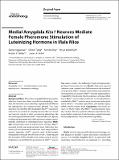Files in this item
Medial amygdala Kiss1 neurons mediate female pheromone stimulation of luteinizing hormone in male mice
Item metadata
| dc.contributor.author | Aggarwal, Sanya | |
| dc.contributor.author | Tang, Celion | |
| dc.contributor.author | Sing, Kirsten | |
| dc.contributor.author | Kim, Hyun Wook | |
| dc.contributor.author | Millar, Robert P. | |
| dc.contributor.author | Tello, Javier Ananda | |
| dc.date.accessioned | 2019-03-01T15:30:19Z | |
| dc.date.available | 2019-03-01T15:30:19Z | |
| dc.date.issued | 2019-04 | |
| dc.identifier | 256866190 | |
| dc.identifier | bf821be4-895a-4bd9-bad8-fc9b6058a7fa | |
| dc.identifier | 85065257812 | |
| dc.identifier | 000467679700002 | |
| dc.identifier.citation | Aggarwal , S , Tang , C , Sing , K , Kim , H W , Millar , R P & Tello , J A 2019 , ' Medial amygdala Kiss1 neurons mediate female pheromone stimulation of luteinizing hormone in male mice ' , Neuroendocrinology , vol. 108 , no. 3 , pp. 172–189 . https://doi.org/10.1159/000496106 | en |
| dc.identifier.issn | 0028-3835 | |
| dc.identifier.other | ORCID: /0000-0001-6637-2155/work/64034520 | |
| dc.identifier.uri | https://hdl.handle.net/10023/17193 | |
| dc.description | This work was supported by the Wellcome Trust Institutional Strategic Support Fund to the University of St. Andrews (awarded to J.A.T.), the British Society for Neuroendocrinology (Project Support Grant to S.A. and J.A.T.), and the RS MacDonald Trust Grant (awarded to S.A. and J.A.T.). | en |
| dc.description.abstract | Background/Aims: The medial amygdala (MeA) responds to olfactory stimuli and alters reproductive physiology. However, the neuronal circuit that relays signals from the MeA to the reproductive axis remains poorly defined. This study aimed to test whether MeA kisspeptin (MeAKiss) neurons in male mice are sensitive to sexually relevant olfactory stimuli and transmit signals to alter reproductive physiology. We also investigated whether MeAKiss neurons have the capacity to elaborate glutamate and GABA neurotransmitters and potentially contribute to reproductive axis regulation. Methods: Using female urine as a pheromone stimulus, MeAKiss neuronal activity was analysed and serum luteinizing hormone (LH) was measured in male mice. Next, using a chemogenetic approach, MeAKiss neurons were bi-directionally modulated to measure the effect on serum LH and evaluate the activation of the preoptic area. Lastly, using in situ hybridization, we identified the proportion of MeAKiss neurons that express markers for GABAergic (Vgat) and glutamatergic (Vglut2) neurotransmission. Results: Male mice exposed to female urine showed a two-fold increase in the number of c-Fos-positive MeAKiss neurons concomitant with raised LH. Chemogenetic activation of MeAKiss neurons significantly increased LH in the absence of urine exposure, whereas inhibition of MeAKiss neurons did not alter LH. In situ hybridization revealed that MeAKiss neurons are a mixed neuronal population in which 71% express Vgat mRNA, 29% express Vglut2 mRNA, and 6% express both. Conclusions: Our results uncover, for the first time, that MeAKiss neurons process sexually relevant olfactory signals to influence reproductive hormone levels in male mice, likely through a complex interplay of neuropeptide and neurotransmitter signalling. | |
| dc.format.extent | 18 | |
| dc.format.extent | 3504779 | |
| dc.language.iso | eng | |
| dc.relation.ispartof | Neuroendocrinology | en |
| dc.subject | Amydala | en |
| dc.subject | Kiss-1 | en |
| dc.subject | Luteinizing hormone | en |
| dc.subject | Male reproduction | en |
| dc.subject | Neuroendocrinology | en |
| dc.subject | QP Physiology | en |
| dc.subject | RC0321 Neuroscience. Biological psychiatry. Neuropsychiatry | en |
| dc.subject | NDAS | en |
| dc.subject | BDC | en |
| dc.subject.lcc | QP | en |
| dc.subject.lcc | RC0321 | en |
| dc.title | Medial amygdala Kiss1 neurons mediate female pheromone stimulation of luteinizing hormone in male mice | en |
| dc.type | Journal article | en |
| dc.contributor.sponsor | The Wellcome Trust | en |
| dc.contributor.sponsor | British Society for Neuroendocrinology | en |
| dc.contributor.institution | University of St Andrews. Cellular Medicine Division | en |
| dc.contributor.institution | University of St Andrews. Biomedical Sciences Research Complex | en |
| dc.contributor.institution | University of St Andrews. School of Medicine | en |
| dc.identifier.doi | 10.1159/000496106 | |
| dc.description.status | Peer reviewed | en |
| dc.identifier.grantnumber | en | |
| dc.identifier.grantnumber | en |
This item appears in the following Collection(s)
Items in the St Andrews Research Repository are protected by copyright, with all rights reserved, unless otherwise indicated.

